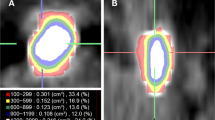Abstract
Impacted stones typically make it difficult to perform ureteroscopic lithotripsy (URSL), so it is useful to preoperatively predict such impaction. We focused on CT attenuation values of the ureter above and below the stone (‘HU above’ and ‘HU below’) and calculated their ratio (HAB ratio; HU above/HU below ratio). The aim was to investigate whether HAB ratio could predict impacted stones preoperatively. Between 2011 and 2019, 171 patients from our hospital that had URSL for ureteral stones with pretreatment non-contrast computed tomography (NCCT) were retrospectively identified. Ureteral wall thickness (UWT), ureteral wall volume (UWV) and HAB ratio (‘HU above’ divided by ‘HU below’) were recorded. Impacted stones were defined as fixed stones that did not move by means of ureteroscopic manipulation or water pressure. Of the 171 procedures, 46 (27%) involved patients with impacted stones. Comparing patient characteristics and stone parameters according to impaction status, factors with significant difference included grade of hydronephrosis, UWT, and HAB ratio (all P < 0.01). Multivariate analysis indicated that significant independent predictors of impacted stones were thicker UWT and lower HAB ratio (all P < 0.01). HAB ratio was a significant preoperative predictor of stone impaction in patients undergoing URSL for ureteral stones. HAB ratio may be informative for selecting the treatment and preoperative preparations.



Similar content being viewed by others
Abbreviations
- AUC:
-
Area under curve
- BMI:
-
Body mass index
- CTU:
-
Computed tomographic urography
- HAB ratio:
-
HU above/HU below ratio
- HU:
-
Hounsfield unit
- IVU:
-
Intravenous urography
- MSD:
-
Mean stone density
- NCCT:
-
Non-contrast computed tomography
- OR:
-
Odds ratio
- SFR:
-
Stone-free rate
- SWL:
-
Shock wave lithotripsy
- URSL:
-
Ureteroscopic lithotripsy
- UWT:
-
Ureteral wall thickness
- UWV:
-
Ureteral wall volume
References
Morgentaler A, Bridge SS, Dretler SP (1990) Management of the impacted ureteral calculus. J Urol 143:263–266
Mueller SC, Wilbert D, Thueroff JW, Alken P (1986) Extracorporeal shock wave lithotripsy of ureteral stones: clinical experience and experimental findings. J Urol 135:831–834
Chaussy CG, Fuchs GJ (1989) Current state and future developments of noninvasive treatment of human urinary stones with extracorporeal shock wave lithotripsy. J Urol 141:782–789
Legemate JD, Wijnstok NJ, Matsuda T, Strijbos W, Erdogru T, Roth B, Kinoshita H, Palacios-Ramos J, Scarpa RM, de la Rosette JJ (2017) Characteristics and outcomes of ureteroscopic treatment in 2650 patients with impacted ureteral stones. World J Urol 35:1497–1506
Roberts WW, Cadeddu JA, Micali S, Kavoussi LR, Moore RG (1998) Ureteral stricture formation after removal of impacted calculi. J Urol 159:723–726
Degirmenci T, Gunlusoy B, Kozacioglu Z, Arslan M, Kara C, Koras O, Minareci S (2012) Outcomes of ureteroscopy for the management of impacted ureteral calculi with different localizations. Urology 80:811–815
Sarica K, Kafkasli A, Yazici O, Cetinel AC, Demirkol MK, Tuncer M, Sahin C, Eryildrim B (2015) Ureteral wall thickness at the impacted ureteral stone site: a critical predictor for success rates after SWL. Urolithiasis 43:83–88
Yoshida T, Inoue T, Omura N, Okada S, Hamamoto S, Kinoshita H, Matsuda T (2017) Ureteral wall thickness as a preoperative indicator of impacted stones in patients with ureteral stones undergoing ureteroscopic lithotripsy. Urology 106:45–49
Ozbir S, Can O, Atalay HA, Canat HL, Cakir SS, Otunctemur A (2019) Formula for predicting the impaction of ureteral stones. Urolithiasis 48(4):353–360. https://doi.org/10.1007/s00240-019-01152-y
Yamashita S, Kohjimoto Y, Iguchi T, Nishizawa S, Kikkawa K, Hara I (2020) Ureteral wall volume at ureteral stone site is a critical predictor for shock wave lithotripsy outcomes: comparison with ureteral wall thickness and area. Urolithiasis 48(4):361–368. https://doi.org/10.1007/s00240-019-01154-w
Yamashita S, Kohjimoto Y, Iwahashi Y, Iguchi T, Iba A, Nishizawa S, Hara I (2019) Three-dimensional mean stone density measurement is superior for predicting extracorporeal shock wave lithotripsy success. Int J Urol 26:185–191
Dretler SP, Young RH (1993) Stone granuloma: a cause of ureteral stricture. J Urol 150:1800–1802
Deliveliotis C, Chrisofos M, Albanis S, Serafetinides E, Varkarakis J, Protogerou V (2003) Management and follow-up of impacted ureteral stones. Urol Int 70:269–272
Baerlocher MO, Asch M, Myers A (2010) Allergic-type reactions to radiographic contrast media. CMAJ 182:1328
Acknowledgements
This document was proof-read and edited by Benjamin Phillis at the Clinical Study Support Center, Wakayama Medical University. The authors are grateful to Takashi Nishiyama, Radiological technologist at Wakayama Medical University, for his help in manuscript writing.
Funding
The authors did not receive support from any organization for the submitted work.
Author information
Authors and Affiliations
Contributions
RD wrote the main manuscript text and prepared figures 1-3 and table 1-2. All authors reviewed the manuscript.
Corresponding author
Ethics declarations
Conflict of interest
All authors declare that they have no conflict of interest.
Ethical approval
All procedures were carried out in accordance with the ethical standards of the institutional and/or national research committee and with the 1964 Helsinki declaration. This study was approved by Wakayama Medical University Ethics Committee (No.3487).
Informed consent
Informed consent was obtained from all individual participants included in the study.
Additional information
Publisher's Note
Springer Nature remains neutral with regard to jurisdictional claims in published maps and institutional affiliations.
Rights and permissions
Springer Nature or its licensor holds exclusive rights to this article under a publishing agreement with the author(s) or other rightsholder(s); author self-archiving of the accepted manuscript version of this article is solely governed by the terms of such publishing agreement and applicable law.
About this article
Cite this article
Deguchi, R., Yamashita, S., Iwahashi, Y. et al. The ratio of CT attenuation values of the ureter above/below ureteral stones is a useful preoperative factor for predicting impacted ureteral stones. Urolithiasis 50, 643–649 (2022). https://doi.org/10.1007/s00240-022-01354-x
Received:
Accepted:
Published:
Issue Date:
DOI: https://doi.org/10.1007/s00240-022-01354-x




